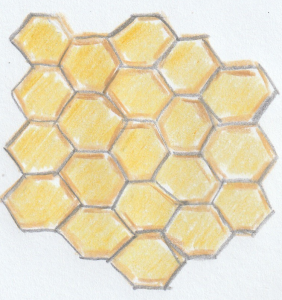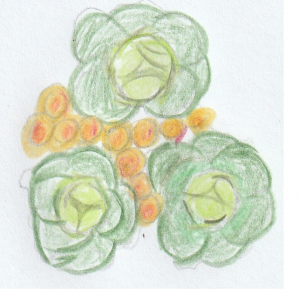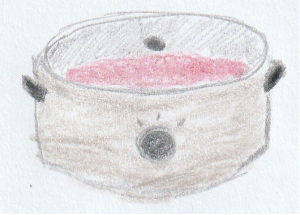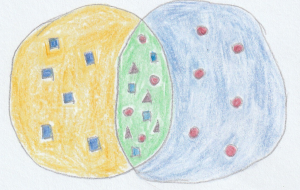How To Permaculture Your Business
Permaculture is a gardening thing, right? Isn’t it all about planting your vegetables in groups and your perennials in guilds, and using organic methods and designing a garden that takes advantage of the natural assets? It’s true that any true permie is a lover of home grown organic vegetables and embracing the timeless ways of nature, but scratch a little deeper, and you discover a pattern – a framework – for a truly harmonious existence that embraces all areas of life. Permaculture is designed on the basis of whole-systems thinking, a holistic approach to recognising that everything impacts everything.

The movement of Permaculture began in the mid-70’s, developed by Bill Mollison and David Holmgren, in Melbourne. It spread all over the world as a set of principles to guide the design of an outdoor (and indoor) space to harness the power of nature for your benefit. It centres on food production and the quality of life. It’s a certain way of thinking and approaching problems, and finding the answers that nature provides. It was developed by studying the ancient cultures around the world and understanding how they live in harmony with the earth. The ethics and principles are to be used in conjunction with each other, and not as stand-alone rules. The ethics are 3 over-arching lenses to use as you apply the principles. They are deliberately kept as rather loose in their definition, to allow for greater adaptation, and to recognise that certain design elements may be introduced in the future that fit well within a certain principle. It also warns that just because a design element ticks a few boxes of a principle, if not understood holistically, it may not in fact be “permaculture”.
From my early childhood, I grew up loving nature, and have always been committed to living in harmony with the earth. I have also earned a profession for most of my adult life in assisting small businesses with accounts and figures and administration. Having a foot firmly rooted in each camp, it was a great joy to me to recognise that the Permaculture Principles that I love so dearly in my garden, also provide the answers to countless issues that are experienced when running a business. My mission now is to teach people how to “Permaculture Your Business.”
This is NOT teaching you to grow carrots alongside your office printer. This is using the PRINCIPLES that work for nature to solve the problems you face in your business. It’s a way of thinking, a way of approaching the issues. A common saying in permaculture is: “The problem IS the solution”. Take a problem, examine it, turn it around, make it work for you instead of against you.

Permaculture begins with 3 over-arching ethics – people care, earth care, and fair share. The people care and earth care is rather self-explanatory. Love the earth, tread lightly, be kind to all nature. Forgive and love other people, we’re all here trying to do our best. Love your fellow humans, for we all share this planet together. Fair share is still rather self-explanatory, in that we do not take more than we need. Don’t be greedy, there is plenty for everyone, and if you have enough, then be happy with that.
Based on this joyous connection of my two loves, I have prepared a brief introduction to the 12 Permaculture Principles, and how they might be used in a business setting.
It’s worth mentioning that in order to apply these principles in business successfully, there is a certain amount of common sense assumed in order to use them appropriately. I won’t be held accountable for anyone who integrates the printer ink colours together instead of segregating them. And it’s not my intention that valuing diversity should replace the standard of delivering a consistent positive customer experience every time. When I talk about small and slow solutions, I am not talking about customer service or the delivery of products and services!
When used wisely, these principles will provide a truly valuable and dependable framework of attitudes and values that will surely benefit your business. By introducing these principles into your business, just one at a time, in small and simple ways, you will find that your business will operate in a more harmonious way. Your people will be happier, your customers will be happier, and you will be happier. Your business may even find ways to become more eco-sustainable, and as this movement spreads throughout the business community, we can in fact change the direction that the world is heading.
If we all do our own little part.

Permaculture Australia is the national permaculture member-based organisation in Australia. Activities include:
- providing small grants to permaculture projects internationally via Permafund
- Supporting Accredited Permaculture education.
Join as a member to help advocate for permaculture solutions here: permacultureaustralia.org.au/join-permaculture-australia/

The Permaculture Association of Western Australia Inc (PermacultureWest) is a not-for-profit incorporated association that aims to help people learn and apply permaculture in their lives. The Association provides an opportunity for members to obtain information and build the skills required to implement permaculture designs by:
- Disseminating permaculture information and resources.
- Promoting the design and construction of permaculture systems.
- Providing opportunities for interested people to meet.
- Seeking contact with any other related groups.
https://permaculturewest.org.au/
 In a garden setting, this means: stop. Just watch for a moment. What is the sun doing? The wind? How are the flora and fauna responding to each other? That kind of thing. Stop and observe before you come in with your shovel and your landscape design, first just be aware of what’s going on now, without your interference.
In a garden setting, this means: stop. Just watch for a moment. What is the sun doing? The wind? How are the flora and fauna responding to each other? That kind of thing. Stop and observe before you come in with your shovel and your landscape design, first just be aware of what’s going on now, without your interference.
This is a rather simple principle to relate to a business setting. Have you ever experienced a new manager starting in a company, one who is so eager to stamp his brand of leadership into this new role that he makes big changes on his first day? In contrast, have you ever experienced a new manager who prefers to start by first blending in, observing the staff, the dynamics, the strengths and weaknesses, and only after sufficient time getting a feel for the place, then makes the necessary changes to improve the things that are broken? Even if you haven’t experienced it first-hand, which would you prefer?
In order to make the most effective impact on a business, anyone (owner, manager, staff member or out-sourced assistance) would be wise to observe what is currently happening. What are the dynamics between the staff and the customers? Between management and staff? How well does the workspace layout work? And if a small adjustment is made, how does it impact the problem being addressed? Does it make it better or worse? Interact means to act WITH, not TO. Engage on the same level, it’s a two-way action. This is an ongoing process, which is touched on again in a principle coming up later, but to observe and interact must always be the first step.
 In a garden setting, this is easy to understand. Harvest energy from sun, wind, rain. It comes free from above, and if you were setting up a permaculture vegetable garden, you would be crazy to not take full advantage of what is freely available to all. Catch it – harness it – and store it to use later, when it’s not available. It just makes a lot of sense!
In a garden setting, this is easy to understand. Harvest energy from sun, wind, rain. It comes free from above, and if you were setting up a permaculture vegetable garden, you would be crazy to not take full advantage of what is freely available to all. Catch it – harness it – and store it to use later, when it’s not available. It just makes a lot of sense!
In a business setting, consider what constitutes ENERGY in your business. There are the obvious advantages to introducing solar power if you are a freehold, and have the ability to do so. The impact of reducing the ongoing cost of utilities can make a huge difference to your profit margin. But think a little harder. What else is energy in your business? The motivation and enthusiasm of fresh new staff members? The wave of goodwill from having a strong reputation in your area? The inspiration that the owner receives after having a great new idea? What brings LIFE to your business?
By catching (harnessing) and storing these seen and unseen sources of energy, you will provide yourself with a much more dependable source of energy when times get tough. Build up a bank of goodwill. Make full use of the sun, the wind, the rain, however you can. Harness this energy to power your business.
 Of all of the permaculture principles, this one is the clearest in terms of relating to business. AKA “Make a profit”. Make sure that all of the effort and money and stress you experience in running a business is worthwhile. It sounds obvious enough, yet there are some businesses which are set up on purpose to fail. Perhaps for a tax write-off or other financial gain elsewhere. But that’s not what business is about. We do what we do to make money.
Of all of the permaculture principles, this one is the clearest in terms of relating to business. AKA “Make a profit”. Make sure that all of the effort and money and stress you experience in running a business is worthwhile. It sounds obvious enough, yet there are some businesses which are set up on purpose to fail. Perhaps for a tax write-off or other financial gain elsewhere. But that’s not what business is about. We do what we do to make money.
Design your business to obtain a yield as quickly as possible. This could mean something like: start small, and don’t over-invest in infrastructure or equipment until the business has proven its viability, and can afford it. It could also mean that you should do your costings thoroughly, to make sure you have captured all of the costs associated with producing your product, as well as having a strong understanding of what your overheads will be BEFORE they happen, so that you can structure your pricing model accordingly, to make sure that you do in fact turn a profit as soon as possible.
The principle to obtain a yield gives honour to the abundance that life has to offer. In the garden, a little love, effort, time and resources (sun and rain) will produce a bounty of a harvest. It’s the earth saying “thank you”. When we run a business, in honouring this principle, we open ourselves up to the majesty of that abundance that’s just there for the receiving – for those who know how to ask for it.

This is a continuation of the principle to “observe and interact”. In this principle, we learn that no one is going to tell us what to do. We can act for ourselves. We can apply self-regulation to regulate what we do – to be guided by our own boundaries and purpose, and by accepting feedback, we can continually refine and improve our actions accordingly.
All feedback is good feedback. It is either a celebration of something you got right, or a heads-up on something you need to fix. And so everything is aimed at continually improving, and refining, and growing, and learning. Being guided by your own boundaries and purpose will remove the temptation to act on every suggestion made by customers, staff, or advisers. It’s your show, you do what you do best. Be true to yourself, and you regulate yourself.
This does require discipline, but then, if you’re a business owner with not enough self-discipline, you’re going to have trouble no matter what. A small business owner must develop a strong habit of self-discipline. There is no bad feedback. Don’t be afraid of people voicing their dissatisfaction at something you’ve done. Think of it as an act of compassion towards your next customer – they are only letting you know so that you can avoid someone else having a negative experience in the future.
 In this principle, we echo again the sentiment of a previous one. First we are catching and storing energy, now we are valuing renewable resources. In a garden setting, we can think of resources as things in terms of energy, but also in terms of tools, knowledge, assistance, labour. A resource is something that we USE. So, if we are going to use something, it only makes sense to value a renewable source of that thing.
In this principle, we echo again the sentiment of a previous one. First we are catching and storing energy, now we are valuing renewable resources. In a garden setting, we can think of resources as things in terms of energy, but also in terms of tools, knowledge, assistance, labour. A resource is something that we USE. So, if we are going to use something, it only makes sense to value a renewable source of that thing.
In a business setting, we can think of resources as energy, like before, and also as things that help us run the physical logistical things in our business. Look around and consider – what resources are you using that are currently finite? Is there a renewable option? Think of your labour. Your physical body provides energy to get work done, and then you get tired, and then you rest, and then you’re good to go again. Your labour is renewable on terms of rest, nutrition, and making sure you remain balanced so you don’t burn out.
There is much to be gained by seeking out renewable resources for the things that your business needs to run. There is the financial gain – it may be a bit of an investment to start with – but as well as that, developing a perspective of choosing renewable over disposable feeds the feel-good part of your soul. You can see very clearly the positive impact you are having on the environment around you.
 This is a perfect principle to follow on from renewable resources. For, when we use renewable, we naturally reduce the amount of waste. The occurrence of disposable items hitting the garbage bin drops profoundly. What other considerations can we include with this principle?
This is a perfect principle to follow on from renewable resources. For, when we use renewable, we naturally reduce the amount of waste. The occurrence of disposable items hitting the garbage bin drops profoundly. What other considerations can we include with this principle?
When we produce no waste, we’re not talking about only ever using stainless steel straws instead of plastic straws, or mugs instead of single-use coffee cups. In every facet of nature, there is waste. The corn stalks after a harvest, the ash left from a fire, the poo from every living creature on the earth. Sure, there will always be waste, but one thing that really brings permaculture alive for me is the renewal of waste into useful material. Poo is composted with other matter and it becomes fertile soil. In designing a permaculture space, a designer will look at the needs of one element and the products of another, and put them together. Put your chooks with your fruit trees, so that the excess fallen fruit can feed the chooks, and the poo from the chooks can feed the trees. Perfect harmony.
In your business, what has been thrown out in the past, that could actually have a second life as something else? We can shred paper to put in compost bins instead of recycling bins, but we can also minimise waste in a thousand different ways in terms of not wasting time, energy, space, inventory, or skills.
 When needing to solve a problem in the garden, this principle teaches us to zoom out first. Take a look at the bigger picture before you start drilling down on the details. For example, an occurrence of leaf rot in one plant could be given the wrong treatment if the cause of the rot is not recognised. Is there an excess of water pooling at the base of the plant? Where is that coming from and why? Why are no other plants affected?
When needing to solve a problem in the garden, this principle teaches us to zoom out first. Take a look at the bigger picture before you start drilling down on the details. For example, an occurrence of leaf rot in one plant could be given the wrong treatment if the cause of the rot is not recognised. Is there an excess of water pooling at the base of the plant? Where is that coming from and why? Why are no other plants affected?
Patterns exist in nature in so many different ways it’s difficult to stop seeing them once you turn your pattern-radar on. When learning about permaculture, we learn to see how patterns exist from the broadest expanse of the universe, down to the way a single leaf is created.
In business, there will be countless problems. There are spot-fires that come up and need to be resolved right now. It’s easy to focus on the one at a time, because it’s there and screaming to be fixed, but it would be wise to step back, zoom out, and see what else is going on. How is this specific problem the result of a failure up-stream? What other problems are happening around this one? The concept of patterns is a fuzzy one to describe at the best of times, but in terms of problem-solving and intentional design, always start with the big picture, and slowly drill down until you get to the smaller details – never the other way around.
 In the garden, there has been wonderful synergies formed by planting different plants together. They help each other – like bigger plants providing shade for sun-sensitive plants, or attracting beneficial fauna, or being nitrogen-fixers in the soil that the next plants will use. The mono-culture of broad-scale farming is often frowned upon, as it deprives the elements from integrating with beneficial flora and fauna that could make their existence so much better.
In the garden, there has been wonderful synergies formed by planting different plants together. They help each other – like bigger plants providing shade for sun-sensitive plants, or attracting beneficial fauna, or being nitrogen-fixers in the soil that the next plants will use. The mono-culture of broad-scale farming is often frowned upon, as it deprives the elements from integrating with beneficial flora and fauna that could make their existence so much better.
If we look at people, we can often see that when people of different backgrounds, cultures, skills and perspectives, when they come together in a spirit of mutual respect and consideration, they will always come away with a better understanding, a higher appreciation, a more tolerant attitude, towards each other. It’s the same in the garden, it’s the same in business.
Management should always be approachable for staff. People – management, staff, customers – should mix freely and be familiar and friendly to each other. What else can we integrate rather than segregate? Perhaps we could have our staff trained in all the different areas of the business? Everyone has their own responsibility, of course, but to have a back-up person who knows what to do in case of an absent employee is a very wise move. Staff can be inter-changeable between departments, and gain a new appreciation for what is required for each role. Whatever we do, let’s mix!
 This is another principle that echoes from the first – to observe and interact. In this one, we look at how any changes we make should be incremental. Try a little adjustment, see how it responds, and then try a little more. To make big and wide-spread changes in a garden causes a lot of plant shock, it interrupts the flow of energy, and all of the natural consequences of the changes made are not always anticipated.
This is another principle that echoes from the first – to observe and interact. In this one, we look at how any changes we make should be incremental. Try a little adjustment, see how it responds, and then try a little more. To make big and wide-spread changes in a garden causes a lot of plant shock, it interrupts the flow of energy, and all of the natural consequences of the changes made are not always anticipated.
Same in a business. There’s a way of doing things, and if any positive change is to be lasting, it must be introduced by degrees. A small shift, a period of time to become accustomed to the new change, and then a gradual increase of the same if it works.
This could be applied in many situations. The one I’m thinking of now is to do with staff, and the way small changes can gradually shift the culture of how the tasks are approached and carried out. But more than that, this could be in making changes to your supply chain, or trialling a new method of delivering your product or service on a few selected customers before adopting it across all of them.
By using small and slow solutions, the process becomes less “start and finish” and more “continual progression” which is really what happens in all of us. We never “arrive” at a point where there’s nothing else we can improve, we always, all of us, are creatures of constant change in imperceptible ways. By honouring this principle of using small and slow solutions, it becomes a very deliberate intent to make that constant change in a positive direction.
 Another principle that goes hand-in-hand with another, this one builds on the principle to integrate rather than segregate. Using and valuing diversity is a attitude that celebrates how different things are wonderful because they are different. In people, we love being unique, being different. To celebrate our diversity is to honour who we are both individually and collectively. There are times when people want to blend in, to be the same as everyone else, but too often this smells like peer pressure, conformism, and rarely ends well. Yes, we are all the same in many ways, and that’s a very good thing, but it’s our diversity that makes us interesting.
Another principle that goes hand-in-hand with another, this one builds on the principle to integrate rather than segregate. Using and valuing diversity is a attitude that celebrates how different things are wonderful because they are different. In people, we love being unique, being different. To celebrate our diversity is to honour who we are both individually and collectively. There are times when people want to blend in, to be the same as everyone else, but too often this smells like peer pressure, conformism, and rarely ends well. Yes, we are all the same in many ways, and that’s a very good thing, but it’s our diversity that makes us interesting.
The same goes with plants in the garden, and most certainly in a business. We love and celebrate that two restaurants can exist next to each other and each of them attracts a different crowd, and they both thrive. Within a business, what works for one employee, or one customer, may not work for another. This should be recognised, honoured, even celebrated. We’re all different. The best marketing strategies will include different platforms or approaches at once, and thereby reaching a wider audience than just a uniform campaign. A business will offer several different options of products or services, so that the customer can experience the delight of making a choice according to their personal preference. Diversity is the spice of life, people, and business.
 This principle has a clear application in nature. To be able to understand how this works in business, you first need to understand it in nature. Consider a forest, and the variety of animals that live amongst the trees. Then, in the forest is a lake. In the lake, you will find an entirely new group of animals that live in the water. Now, consider the edge, where the lake meets the forest. Not only do the animals from the forest go to drink at the lake, and the animals in the water go to the shore for food or rest, but there is also a whole new group of animals that live in that edge. The mosquitoes that will be food for fish, the frogs, the microscopic organisms that thrive in the calm, wet, shallow edge. The edge is where the magic really happens.
This principle has a clear application in nature. To be able to understand how this works in business, you first need to understand it in nature. Consider a forest, and the variety of animals that live amongst the trees. Then, in the forest is a lake. In the lake, you will find an entirely new group of animals that live in the water. Now, consider the edge, where the lake meets the forest. Not only do the animals from the forest go to drink at the lake, and the animals in the water go to the shore for food or rest, but there is also a whole new group of animals that live in that edge. The mosquitoes that will be food for fish, the frogs, the microscopic organisms that thrive in the calm, wet, shallow edge. The edge is where the magic really happens.
In a garden, you will see this as you increase the linear edge of garden beds, lined with herbs or other companion plants, you will fit a great deal more along a wavy edge than a straight one. The edge is where the magic happens.
In business, what constitutes the edge for you? Perhaps that transition between marketing (making your customers aware of your product or service) and operations (the delivery of your product or service to them)? Or the transition from operations to finance (the money from your customer that keeps your business afloat)? Consider the magic that happens at each of those transitions? Or perhaps consider the edge when an apprentice becomes a fully qualified tradesman? Or where the office staff interact with the factory staff? At each of these edges, there is a clear transition from one to the other. A shift in the environment, and redirection of the perspective, a different process to be followed. This is where the magic happens. Explore it!
 Change has gotten a mention a few times in other principles, and now it gets the focus in this one. We all change. The world – the earth, all of nature, people and populations, the plants and animals, the universe – is in a constant state of change. When we run a business we need to recognise that nothing will ever stay exactly the same as it was yesterday. Sure, you might develop a system that really works, and you want it to repeat over and over again like a robot to get the best result every time. Sorry buddy, it doesn’t always happen like that.
Change has gotten a mention a few times in other principles, and now it gets the focus in this one. We all change. The world – the earth, all of nature, people and populations, the plants and animals, the universe – is in a constant state of change. When we run a business we need to recognise that nothing will ever stay exactly the same as it was yesterday. Sure, you might develop a system that really works, and you want it to repeat over and over again like a robot to get the best result every time. Sorry buddy, it doesn’t always happen like that.
Yes, I love systems and the repetition of processes to make business operations run smoothly and efficiently. I really love it! But to have an expectation of nothing within those elements changing is very foolish. Anyone who is a parent knows just how quickly things change as they watch their babies become toddlers and children and teenagers and then adults. It literally happens in the blink of an eye. What we were saying before – about those imperceptible adjustments in small and slow solutions – change happens a little bit at a time, and this principle focuses on the fact that it happens all the time.
To honour this principle, we recognise that change is inevitable, and we should use it to our advantage. In the garden if we prune back a tree a little too hard, it’s ok, it will grow out again. Try something different next season. No matter what we do, it won’t last. That’s not said in a negative way, it’s just a fact of life that whatever we do will have its season, and then it will be time for something new. Respond to change with a keen curiosity. What will happen this month? Whether it’s good or bad, it’s ok, something else will change next.